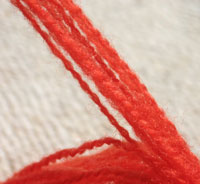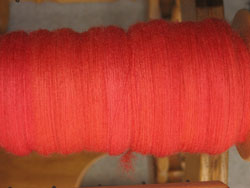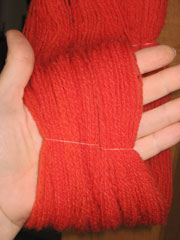Videos
Return to
Articles
page

Spinning Worsted
Adventures with Shortdraw Drafting
Long ago, wool yarns were described as "worsted", or "woollen", or something in-between. A true "worsted" yarn is spun from combed fibre and is dense and fairly smooth. (A true "woollen" yarn, on the other hand, is open, airy, fuzzy, and warm, its fibres comfortably tangled and spiralling down the length of the yarn.)
Worsted spinning is done with a short drafting movement. This technique has many names: worsted drafting, short-draw, inchworm, forward-draft.... It's simple and straightforward, as this video demonstrates.
With high-quality combed wool, drafting this way makes a smooth, dense yarn. This technique is great for other combed fibres, too, maximizing the sheen of silk, Tencel, or bamboo. It also works beautifully with alpaca, and with short fibres that are otherwise hard to control. A variant of this technique makes a true worsted from locks of fibre that have been combed or hackled, putting freshly combed fibre into your hands with minimal equipment.
A reading list at the end of this page opens the door to more in-depth information, if you're interested -- scroll down to see it. ...And happy viewing! :-)
(This article is still under construction, with more videos and text to come in the next week. Thank you for your patience, and check back again!)

The vocabulary of woolcombing and worsted spinning is vast, rich, and deeply rooted in tradition. Here's a sampling:
♦ Combs ...
♦ Pad ...
♦ Diz ...
♦ Sliver ...
♦ Top ...
♦ Roving ...
♦ Planking ...
♦ Jigging ...

Suggested Reading
Most spinning textbooks teach how to draft by presenting some variation of shortdraw. Chances are that most of the spinning books in your possession discuss shortdraw drafting at length, even if they don't call it that or talk specifically about worsted.
This is not an exhaustive book list, as it does not include the widely available "teaching" texts, but rather focusses on books that contain sections or chapters specifically about worsted spinning:
♦ Teal, Peter. Hand Woolcombing and Spinning. This is the definitive text on woolcombing and worsted techniques and traditions. With this book, you need no other.
♦ Baines, Patricia. Spinning Wheels, Spinners and Spinning. Clear instructions on spinning true worsted and semi-worsted yarns, covering combing and shortdraw.
♦ Davenport, Elsie. Your Handspinning. Clear shortdraw instructions are in the section describing worsted spinning.
♦ Ross, Mabel. The Encyclopedia of Handspinning. Clear, concise descriptions of worsted yarns, shortdraw drafting, and spinning from combed locks. A good source for terminology.
♦ Fannin, Allen. Handspinning - Art & Technique. This older (1970) book bridges the gap between industrial spinning and handspinning techniques. Each gesture in shortdraw drafting is analyzed and described, with an eye toward efficiency. Technical and meticulous.